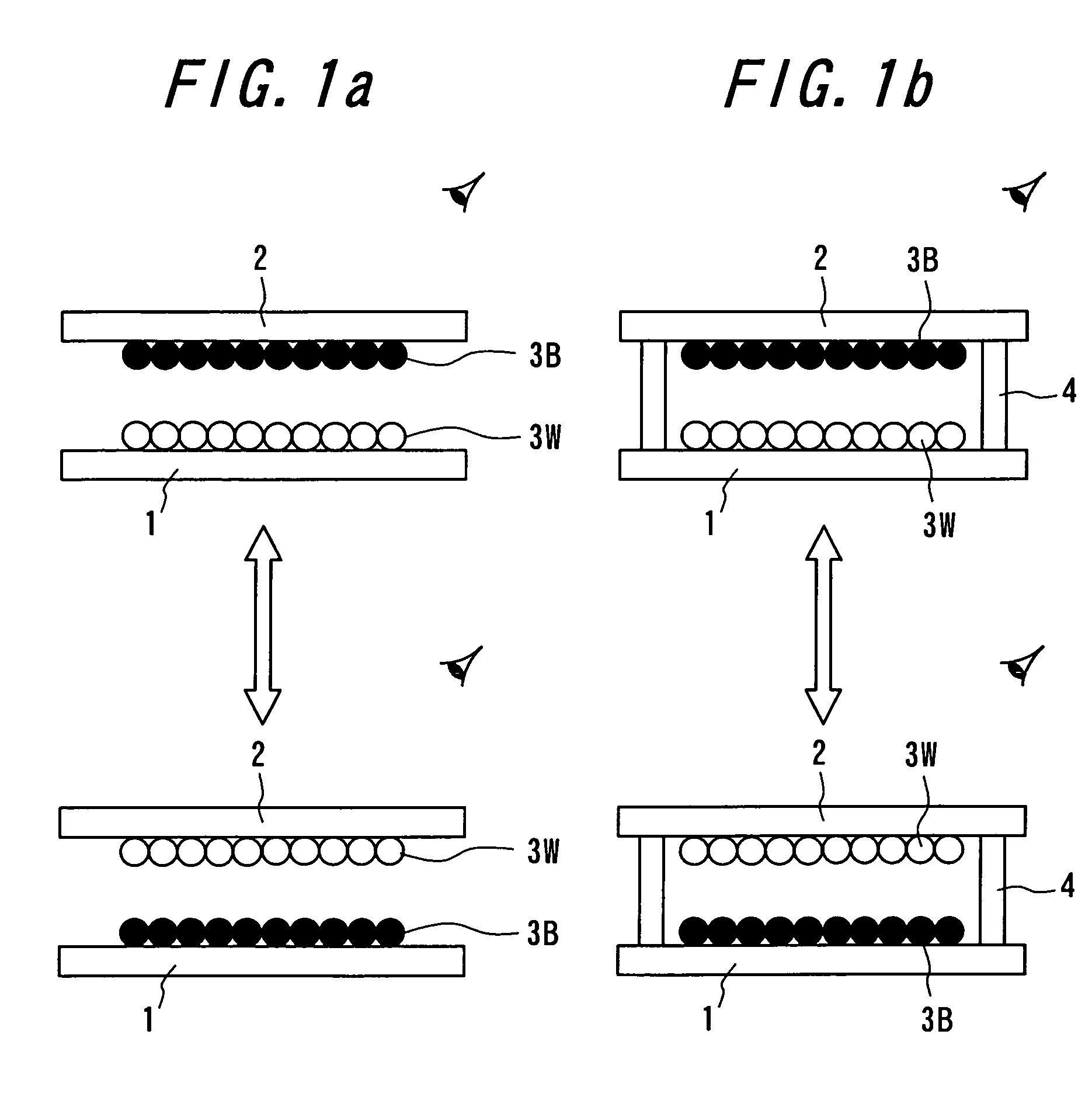Particle use for image display media, image display panel using the particles, and image display device
a technology of image display media and particle, applied in the direction of static indicating devices, instruments, optics, etc., can solve the problems of lack of imaging repetition stability, slow response rate, and difficulty in maintaining a stable dispersion sta
- Summary
- Abstract
- Description
- Claims
- Application Information
AI Technical Summary
Benefits of technology
Problems solved by technology
Method used
Image
Examples
example 1
Particles
[0258]An aluminum ball having an average particle diameter of 7.0 μm was used for the center portion constituting a core. A total reflection rate on the surface of the aluminum ball constituting the center portion to be used (corresponding to a boundary between the center portion and the outer portion) was 85%. The known white material was coated to the aluminum ball constituting the center portion by means of Agglomaster (HOSOKAWA MICRON CORPORATION) so as to form the outer layer portion, and the white particle according to the invention was obtained.
[0259]The white material was produced in such a manner that acrylic urethane resin: EAU53B (Asia Industry Co., Ltd.) / IPDI cross-linking agent: Excel-Hardener HX (Asia Industry Co., Ltd.), titanium oxide 10 phr, charge control agent: BontronE89 (Orient Chemical Industries Ltd.) 2 phr were added, mixed, ground and classified by a jet-mill.
[0260]The thus produced white particle had an average particle diameter of 9.0 μm and a sur...
example 2
Particles
[0261]A particle, in which aluminum was deposited by 500 nm on a PMMA ball having an average particle diameter of 5.0 μm, was used as the center portion constituting the core. A total reflection rate on the surface of the aluminum deposited film constituting the center portion to be used (corresponding to a boundary between the center portion and the outer portion) was 82%. The known white material was coated to this center portion by means of Agglomaster (HOSOKAWA MICRON CORPORATION) so as to form the outer layer portion, as is the same as the example 1, and the white particle according to the invention was obtained.
[0262]The thus produced white particle had an average particle diameter of 8.0 μm and a surface charge density of −50 μC / m2. Moreover, luminance factors of the base white particle and the white particle according to the invention were measured, and as a result, the luminance factor of the white particle according to the invention was improved by 4% with respect...
example 3
Particles
[0263]A particle, in which titanium oxide having a film thickness of 80 nm and silicone oxide having a film thickness of 100 nm were alternately deposited on a PC ball having an average particle diameter of 5.0 μm, was used as the center portion constituting the core. A total reflection rate on the surface of the deposited film constituting the center portion to be used (corresponding to a boundary between the center portion and the outer portion) was 91%. The known white material was coated to this center portion by means of Agglomaster (HOSOKAWA MICRON CORPORATION) so as to form the outer layer portion, as is the same as the example 1, and the white particle according to the invention was obtained.
[0264]The thus produced white particle had an average particle diameter of 7.0 μm and a surface charge density of −60 μC / m2. Moreover, luminance factors of the base white particle and the white particle according to the invention were measured, and as a result, the luminance fac...
PUM
| Property | Measurement | Unit |
|---|---|---|
| particle diameter | aaaaa | aaaaa |
| particle diameter | aaaaa | aaaaa |
| reflectance | aaaaa | aaaaa |
Abstract
Description
Claims
Application Information
 Login to View More
Login to View More - R&D
- Intellectual Property
- Life Sciences
- Materials
- Tech Scout
- Unparalleled Data Quality
- Higher Quality Content
- 60% Fewer Hallucinations
Browse by: Latest US Patents, China's latest patents, Technical Efficacy Thesaurus, Application Domain, Technology Topic, Popular Technical Reports.
© 2025 PatSnap. All rights reserved.Legal|Privacy policy|Modern Slavery Act Transparency Statement|Sitemap|About US| Contact US: help@patsnap.com



